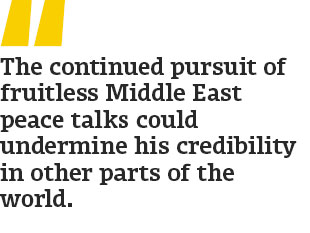
Afghan security forces cast their votes at a polling station in Kabul, Afghanistan, Saturday, April 5, 2014. Massoud Hossaini/AP
After Afghan Election, Debate Over Post-2014 Troops Continues
Military and diplomatic officials worry that the gains in Afghanistan will be lost if U.S. and NATO forces pack up and leave. By Gayle Tzemach Lemmon
As Afghans head to the polls Saturday to elect their next president, those in Washington still pushing for a lasting United States commitment to the country are hoping fervently that things go well – or at least well enough – to keep both the Obama administration and the American public on board.
Lately, the narrative in the U.S. around the Afghanistan War has hardened into one that shows it as a futile effort that has yielded little gains, despite more than 2,300 Americans killed and $600 billion spent since 2001. A December CNN poll revealed American opposition to the Afghan war hit 82 percent – higher than the Iraq War ever reached. Only one quarter of respondents wanted to see U.S. troops stay in Afghanistan after the official end of the war in December. National Intelligence Estimate predictions that security gains will retreat alongside the U.S. troop withdrawal, regardless of whether several thousand troops remain, have strengthened the hand of those within the administration arguing for the so-called “zero option” of keeping no troops in the country come January.
But those who have worked in Afghanistan on the diplomatic and military sides push back against that storyline and point to very real progress.
“I am cautiously optimistic about what I am seeing in Afghanistan,” retired Adm. James Stavridis, former NATO commander who now heads Tufts University’s Fletcher School of Law and Diplomacy, told
Defense One
. “Despite unrelenting media focus on the difficult challenges of getting through the election and the ongoing insurgency, I think the macro picture is actually somewhat encouraging.”
Stavridis, like many commanders and aid workers, pointed to millions of Afghan girls and boys in school and economic growth as high as 13 percent in recent years. Women, too, have made gains, serving as parliamentarians, governors, entrepreneurs, judges, police officers and civil servants after being banished from their streets and schools under the Taliban. Stavridis also praised Afghan security forces. “We now have 350,000 Afghan police and soldiers in the field and they are fighting well,” he said. “They are taking casualties, but inflicting casualties, they are holding territory and the Taliban have made no significant gains whatsoever in terms of holding territory.”
Those who had a front-row seat to training Afghan forces agree. “I remember watching in 2006 and they couldn’t do the most basic things, and now man-for-man some of their folks are as good as ours. And as units, some of their units are as good as those in the NATO coalition,” said Mark Jacobson, former deputy NATO senior civil representative who advised retired Generals David Petraeus and Stan McChrystal during their years commanding the war. “Even back in 2009 they handled the [attack on] the Intercontinental [Hotel] far better than Indian special operations forces handled Mumbai.”
Administration officials who are focused on the country say Afghans now have more to lose if elections don’t go well and the country descends into chaos. They are hopeful, given the statements of all the presidential candidates, that the country’s next president will sign the bilateral security agreement, or BSA, with the U.S. that has sat for months on Afghan President Hamid Karzai’s desk.
(Related: The U.S. Military’s Most Crucial Mission Yet in Afghanistan)
“You see all over Afghans wanting to maintain the gains they have made and move forward in a positive way,” said one senior State Department official. “It is a way-different Afghanistan in 2014 than it was in 1989, and it is a way-different Afghanistan than what we found in 2001. We have a much more educated youth population, we have a much more capable government and we have agencies and institutions that are much different from [1989 to the 1990s], which led to a civil war and to a vacuum of power.”
Secretary of State John Kerry is said to support keeping a small number of U.S. troops in Afghanistan past the end of the year, diplomatic sources told Defense One . In a statement ahead of the election, Kerry said “the United States is ready to work with the next president, and we look forward to an enduring partnership with the Afghan people, consistent with our shared democratic values and interests.”
Now, officials behind the scenes are jockeying over when President Barack Obama should announce his decision on a U.S. troop commitment, regardless of the number of troops or whether a BSA is signed. In February, he instructed his military commanders to begin planning for a complete withdrawal from Afghanistan, while still holding out hope that a BSA would be signed.

Building confidence among Afghans that they will not be abandoned by the international community, officials in both the Pentagon and State Department have argued recently, is critical to avoiding a power vacuum and the chaos of civil war and a fully failed state. Gen. James Dunford, commander of U.S. forces in Afghanistan, in his March testimony to the Senate Armed Services Committee, said that a signed security deal would “address the Afghan people’s concerns and damage the Taliban’s confidence.”
Stavridis goes even further and urges the Obama administration to announce a troop commitment before the BSA is signed. “The sooner we make an announcement that, assuming the BSA is signed, we are willing to support a troop level certain, I think the better for Afghans and Afghanistan,” Stavridis said, echoing retired Gen. John Allen , former commander of U.S. forces in Afghanistan, who urged the White House last May to make a troop announcement.
But some officials have urged that if the decision was to completely withdraw, it would be better to wait until after the April 5 election, for fear of disrupting the vote.
Administration officials working on Afghanistan have struggled to keep the country on the agenda amid Iran, Syria, the Middle East peace process and now Ukraine. The next few months are critical to winning a commitment to Afghanistan from their offices in Washington. “Commitments were made in Tokyo and Chicago in 2012” to Afghanistan, “but clearly those can only be met if the Afghans themselves do certain things that will make it palatable for us in Washington and other allied capitals to keep the finance flowing,” said another State Department official. “The most important of those is the political transition: if there is not a smooth transition from Karzai to a successor, then you can forget about asking Congress to pour billions of dollars into Afghanistan.” Pointing to the bleak NIE findings, the official noted, “there is a lot of reluctance in the White House to really meet long-term commitments when there is skepticism about whether those are going to achieve what they are intended to.”
And that commitment includes the discussion of troops. Last summer, a senior administration official challenged the view that “anybody here in Washington thinks the ‘zero option’ is a real prospect.” Today, that possibility is indeed real.
“There has been a long debate within the administration about what the level of our presence should be going forward, and the ‘zero option’ is a real option that credible people with high positions of authority are mulling and proposing,” the second State Department official said. “There are others who think that that is shortsighted and are working feverishly to get the BSA signed, but it is not a done deal. So when you hear the president in the State of the Union and other senior officials talk about ‘if there is a BSA signed we could leave behind a residual force,’ that is true but the key word in that sentence is ‘could’ – it doesn’t mean we will.”
Pentagon planners continue to come up with various troop-level scenarios for the administration. Thus far, there is no sense that any final decision on U.S. forces post-2014 has been made. Dunford has recommended a force of 8,000 to 12,000 U.S. and NATO forces and a small force to conduct counterterrorism operations. But what is clear is that Saturday’s election will mark the start of the next round of deliberation.
NEXT STORY: Fort Hood Shooter: Why Did He Do It?
